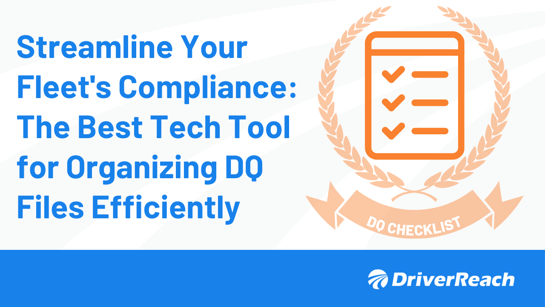If part of your job is to help your company stay in compliance with the Federal Motor Carrier Safety Regulations (FMCSRs), you may have wondered whether an electronic signature, captured from a driver, a mechanic, or perhaps even yourself, on an FMCSA-required document is legal and acceptable in all cases.
 A good example is a driver’s electronic signature, or electronic acceptance and submission, of an application for employment. Is this legal and compliant?
A good example is a driver’s electronic signature, or electronic acceptance and submission, of an application for employment. Is this legal and compliant?
Or, what about a driver electronically checking a box on an electronic form to authorize the company to request the driver’s drug and alcohol testing history from previous employers? Does this constitute an electronic signature and, if so, is it legally authorized by the Federal Motor Carrier Safety Administration?
The short (and general) answer is yes, but please read on to learn at least one twist.
If you’ve searched for a section in the FMCSRs that specifically authorizes electronic signatures on employment applications, and all of the other required compliance documents, you probably came up empty. If so, you didn’t miss it...there is no specific rule in the FMCSRs that authorizes electronic signatures.
The good news, though, is that in 2011, FMCSA issued guidance concerning electronic signatures and documents to comply with the FMCSA regulations. This guidance was in the form of ‘Questions & Answers’ on the topic. Thirteen Q&As to be exact, and they constitute official Agency guidance that can be relied upon by company safety and compliance staff.
When FMCSA published these Q&As, they decided that the closest section of the regulations being interpreted was Section 390.31, “Copies of records or documents.” So, if you’re looking for these Q&As, look under Section 390.31 because most copies of the FMCSRs sold by compliance service companies include official FMCSA guidance under the regulation section being interpreted. To save you some time, though, a link to these Q&As, and FMCSA’s 2011 Notice, can be found here: https://www.gpo.gov/fdsys/pkg/FR-2011-01-04/pdf/2010-33238.pdf
In addition to explaining that this guidance exists, and providing a link to the Q&As, we thought we’d highlight two of the most relevant ones:
Question 5 (of the 13) poses a pretty simple question, “What is an electronic signature?” FMCSA’s guidance states, “An electronic signature is a method of signing an electronic communication that: (1) identifies and authenticates a particular person as the source of the electronic communication; and (2) indicates such person’s approval of the information contained in the electronic communication. An electronic signature may be made using any available technology that otherwise satisfies FMCSA’s requirements.” A simple question with a pretty straightforward answer.
Question 8 (of the 13) also poses a pretty straightforward question, “Are motor carriers and other interested parties required to use electronic methods?” FMCSA’s answers it as you might guess. The guidance says, “No. Interested entities may choose whether or not to use electronic methods or traditional paper methods. Where there are two parties to a transaction, both parties must agree to conduct business using electronic methods.”
It's important to adapt to technology that is designed to improve the process of conducting business. Especially when the shortage of drivers is at an all-time high, companies that embrace technology and progress can still thrive.
DriverReach's mobile-friendly DOT application includes an electronic signature submission that fully meets the FMCSA guidance for both of the highlighted questions.
By Dave Osiecki, President of Scopelitis Transportation Consulting. If you still have questions, contact DriverReach’s regulatory expert, Dave Osiecki at dosiecki@scopelitisconsulting.com.




